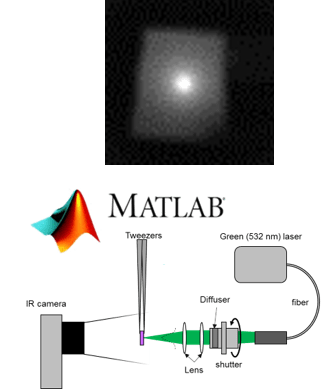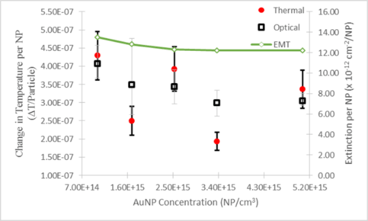Thermoplasmonic Decay of Metal-Polymer Nanocomposites
Student: Tyler Howard
Major Professor: Dr. Keith Roper
Research Area(s):
Nanoscience and Engineering
Photonics
Background/Relevance
- Randomly arranged nanoparticles in a polymer have been found to resonant with a certain wavelength of light and emit or scatter light or gain energy as heat.
- Recently it has been discovered that the extinction per nanoparticle of gold nanoparticles in PVP film is has a decreasing trend according to concentration.
Innovation
- Determine the change in temperature per nanoparticle and compare with extinction per nanoparticle.
- Data can influence the concentration of nanoparticles needed to wipe out a cancer cell.
Approach
- Shine a concentrated, 532 nm, green laser beam onto samples of PVP film with varying concentration of gold nanoparticles.
- Use a thermal imaging camera to record the temperature change and thermodynamic properties of each concentration of PVP film.
- Analyze images using MATLAB program to determine thermal properties of gold nanoparticle PVP films.

Key Results
- Average tau value for each concentration of gold nanoparticles was approximately 22 seconds while earlier work indicated tau values of ~ 5 seconds
- Change in temperature per nanoparticle values range from 1.93 to 4.93 x 10-7 °C/Particle.

Conclusions
- Change in temperature per NP decreases as concentration increases, and matches extinction per NP and EMT.
- Decreasing trend in ΔT per NP implies there is an ideal concentration where a higher temperature cannot be obtained.
- Decreasing trend implies an optimal minimum concentration for any required temperature change.
- Compared with previous results, PVP film appears to be thermally insulating gold nanoparticles beyond expectation.
